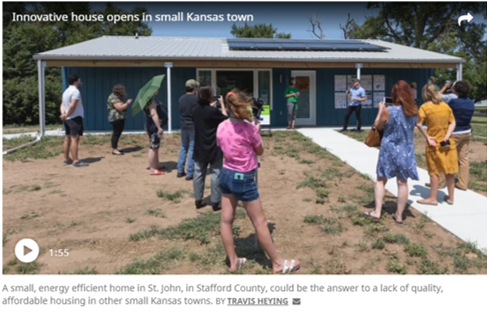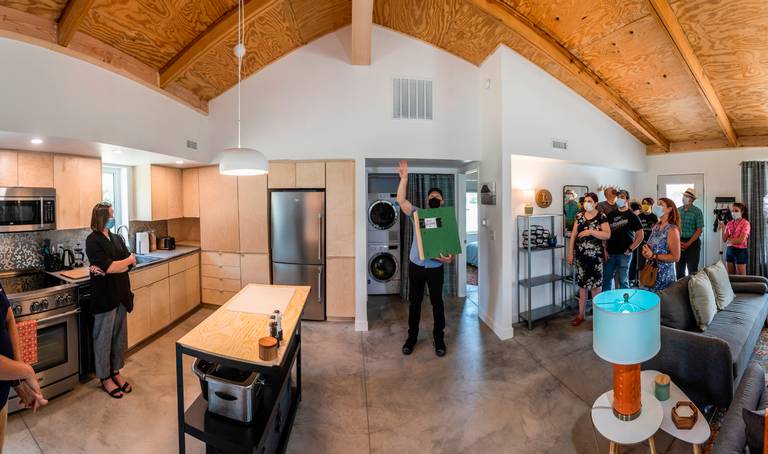K-State’s $100K net-zero prototype house is finished.
By Sarah Spicer for The Wichita Eagle published August 12, 2021
See the original article and a short video here: K-State builds affordable, energy-efficient solar house | The Wichita Eagle (kansas.com)
Watch Travis Heying’s video here.
It’s 100 degrees and sweltering outside at 2 p.m. on an August summer afternoon in Kansas, but despite the 15 warm bodies, the number of times the door has swung open and shut and the fact that the air conditioning hadn’t been on for over six hours, it’s still cool inside the house. It’s not magic or luck.
The house is designed that way.
For the last two years, Michael Gibson, a licensed architect and associate professor of architecture at Kansas State University, has been working with students to design and build a net-zero home, making as much electricity as it uses, but will also be affordable enough that a median family could live there.
Now the three bedroom, two bathroom house is finished. Only 1,100 square feet, it has enough space to accommodate a living room with two couches, a coffee table and an entertainment center, a dining room with a six-person dining set, a laundry nook and a full kitchen.
Keeping with the sustainability theme, the kitchen countertops are crafted out of recycled toilets that couldn’t be used when they were damaged during manufacturing.
The house is powered by 4.3 kw of solar panels on the roof. Since the house should only need 3.8 kw to reach net zero, the owners should see a surplus of energy and the panels should pay for themselves in less than 10 years.
“We built the house as a group of volunteers learning as we go,” Gibson said.“There’s not a lot of houses in our area that are sustainable as well as affordable,”
If mortgaged, a house like this would be between $100,000 and $125,000. Construction costs were minimized as the house was prefabricated and the students modeled the house on a computer, so they could be deliberate with their materials.
“We knew how many studs were in this house before we built it,” Gibson said.
Located in St. John, a small town of less than 2,000 about 90 minutes northwest of Wichita, the home is owned by Stafford County Economic Development, a local nonprofit that received grant funding to build nine more houses of this design.
“We need more affordable housing in rural areas,” said Carolyn Dunn, executive director of Stafford County Economic Development. “What I’m most excited about is how this house can be replaceable . . . We hope this research project will be replicated statewide. I don’t think there’s a rural county in Kansas that isn’t having a housing problem right now.”
As part of the conditions of the grant the nonprofit received to build the houses, Stafford County Economic Development will own the houses for at least 20 years and rent them for $500-$550 a month.
“That sounds expensive, especially since we’re targeting low income people, but we have to charge that because of operational costs,” Dunn said.
The Kansas Housing Resources Corporation is currently working on a statewide housing study, the first in 30 years.
“We hear all the time that rural communities need housing,” said Alissa Ice, director of housing development at KHRC, which gave $50,000 to the project. “This exceeds my expectations and seeing that our funds can help meet community needs is great. It’s what we hope for all of our developments.”
Michael Gibson, associate professor of architecture at Kansas State, talks about some of the processes that went to building this small, energy efficient home in St. John.
TRAVIS HEYING THE WICHITA EAGLE





